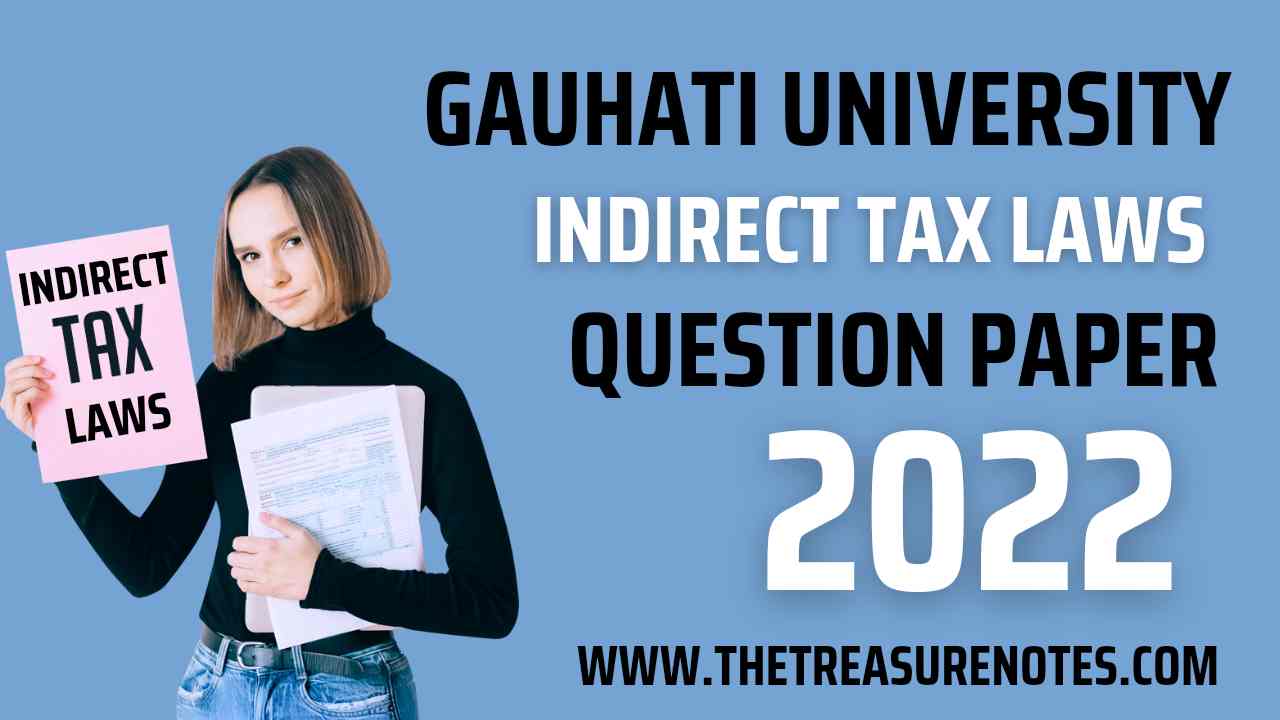In this post, you will get the actual Gauhati University BCom 6th Sem Indirect Tax Laws Question Paper 2022. GU Indirect Tax Laws Question Paper can be very useful for your exam preparation. We believe Indirect Tax Laws Question Paper will help you in many ways as you prepare for your exams. Scroll down to see the complete question paper.
An Overview of GU Indirect Tax Laws Question Paper 2022
Name of Exam: Gauhati University BCom 6th Semester Examination
Subject/Course: Auditing and Corporate Governance
Exam Type: Offline written Exam
Year: 2023
Paper Code: COM-HC-6026
Full Marks: 80
Official Website: https://gauhati.ac.in/
Gauhati University BCom 6th Sem. Indirect Tax Laws Question Paper 2022
2023
COMMERCE (Honours)
Paper: COM-HC-6026
(Indirect Tax Laws)
Full Marks: 80
Time: Three hours
The figures in the margin indicate full marks for the questions.
1. Answer any ten of the following questions as directed: 1 x 10=10
(a) Central excise duty is levied and collected by _______. (Fill in the blank with appropriate word/words)
(b) The Assam VAT Act, 2003 came into effect from the 1st day of May, 2005. (State whether the statement is true or false)
(c) One of the objectives of the Customs Act, 1962 is to protect the domestic industries. (State whether the statement is true or false)
(d) GST has removed the _______ effect of taxes. (Fill in the blank with appropriate word/words)
(e) A person without GST registration can collect tax. (State whether the statement is true or false)
(f) Indirect taxes are imposed on _______ and services. (Fill in the blank with appropriate word/words)
(g) Customs duty is levied on the manufacture of excisable goods in India. (State whether the statement is true or false)
(h) _______ area means the area of a custom station. (Fill in the blank with appropriate word/words)
(i) GST was introduced in India with effect from _______. (Fill in the blank with appropriate word/words)
(j) GSTIN is a unique 10-digit number. (State whether the statement is true or false)
(k) Customs duty is levied by the Government of India. (State whether the statement is true or false)
(l) France was the first country to implement GST in the year _______. (Fill in the blank with the appropriate year)
(m) The name of the first Chairperson of the GST Council was _______. (Fill in the blank with appropriate word/words)
(n) GST network is a non-government organization. (State whether the statement is true or false)
(o) GST has been projected as ‘One Nation, One Tax’. (State whether the statement is true or false)
2. Answer any five of the following questions: 2 x 5=10
(i) What is input tax credit?
(ii) Explain the meaning of ‘aggregate turnover’ under GST laws.
(iii) What is the dual GST model?
(iv) What is the meaning of ‘territorial waters’ under Customs Law?
(v) Explain the term ‘manufacturer’ under the Central Excise Act.
(vi) What is ‘countervailing duty’ under the Customs Act?
(vii) What is the meaning of indirect tax?
(viii) Mention any two salient features of the GST network?
3. Answer any four questions: 5 x 4=20
(i) Explain the meaning of ‘baggage’ under Customs Law.
(ii) Briefly explain any five advantages of registration under GST laws.
(iii) Briefly explain any five salient features of GST.
(iv) Explain the procedure of registration under the Central Excise Act.
(v) State any five objectives of enactment of the Customs Act, 1962.
(vi) Briefly explain any five features of indirect taxes.
(vii) Write a short note on the GST Council and its constitution.
(viii) Write a brief note on the threshold limits for registration under GST.
Also Read: Gauhati University Indirect Tax Laws Question Paper 2023
4. Answer any four of the following questions: 10 x 4=40
(a) Explain the eligibility and conditions for availing input tax credit under GST. 5+5=10
(b) Write a comprehensive note on the persons who are not liable for registration under the Goods and Service Tax Act.
(c) Describe the history of indirect taxes in India.
(d) Write a note on the concepts and general principles of Value Added Tax.
(e) Briefly describe the history of Central Excise Law in India.
(f) Write brief note on the following terms under Central Excise Act: 5+5=10
(i) Manufacture.
(ii) Place of removal.
(g) Explain the provisions of the Customs Act, 1962 regarding grant of exemptions from custom duty.
(h) Briefly explain the following terms under the Customs Act, 1962: 5+5
(i) Safeguard Duty.
(ii) Anti-Dumping Duty.
(i) Briefly describe the history of Goods and Services Tax in India.
(j) Explain the meaning of the composition scheme under GST. What are the conditions for opting for a composition scheme? 5+5=1
-00000-
Last Words
The difficulty level of the Gauhati University BCom 6th Semester Indirect Tax Laws Question Paper 2022 seems balanced. It challenges students to display a grasp of the subject matter while maintaining fairness, in question formulation.

